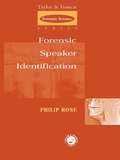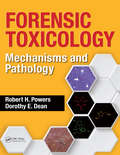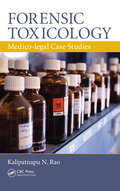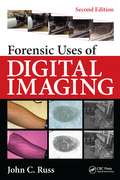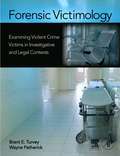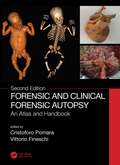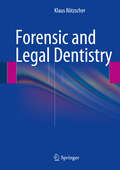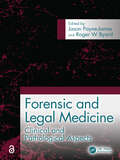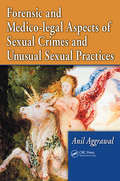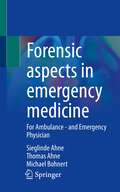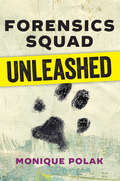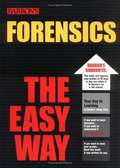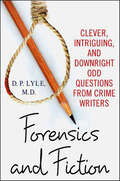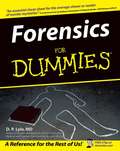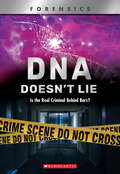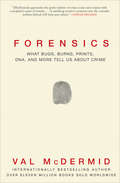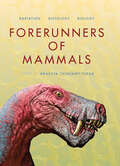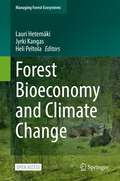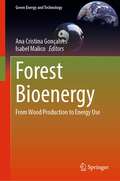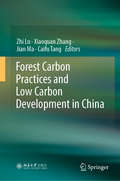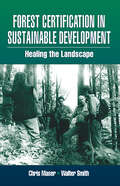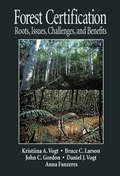- Table View
- List View
Forensic Speaker Identification
by Phil RoseA voice is much more than just a string of words. Voices, unlike fingerprints, are inherently complex. They signal a great deal of information in addition to the intended message: the speakers' sex, for example, or their emotional state, or age. Although evidence from DNA analysis grabs the headlines, DNA can't talk. It can't be recorded planning,
Forensic Toxicology: Mechanisms and Pathology
by Robert H. Powers Dorothy E. DeanDesigned for graduate and advanced undergraduate courses, this book goes beyond the simple analysis of naming a drug or toxin, taking a mechanistic approach to their effects on the body. It provides an understanding of the mechanisms of action of drugs and toxins as well as their physiologic and pathologic consequences on the affected organ system. Case histories, photographs of gross pathology, and photomicrographs further illustrate the processes and effects of toxic substances on the body.
Forensic Toxicology: Medico-Legal Case Studies
by Kalipatnapu N. RaoModern technology using state-of-the-art equipment can now identify almost any toxin relevant to a legal issue. Techniques include gas chromatography, mass spectrometry, high-pressure liquid chromatography, and the combination of these methods. Forensic Toxicology: Medico-legal Case Studies demonstrates how the science of forensic toxicology acts a
Forensic Uses of Digital Imaging
by John C. Russ Jens Rindel P. LordThe ability to work with, and retrieve images, is vital to forensic and criminal case work. During a five-decade-long career, author John C. Russ has taught methods for image processing and measurement to thousands of students. Forensic Uses of Digital Imaging, Second Edition distills his classroom and workshop material to present the information m
Forensic Victimology: Examining Violent Crime Victims in Investigative and Legal Contexts
by Brent E. Turvey Wayne PetherickThis new textbook provides students with the basic principles and practice standards of forensic victimology -the scientific study of victims for the purposes of addressing investigative and forensic issues. It provides case-based coverage with original insights into the role that victimology plays in the justice system, moving beyond the traditional theoretical approaches already available. The purpose of this textbook is to distinguish the investigative and forensic aspects of victim study as a necessary adjunct to the field of victimology. It identifies forensic victimologists in the investigative and forensic communities and provides them with methods and standards of practice needed to be of service. This book is intended to educate students on the means and rationale for performing victimological assessments with a scientific mindset. Forensic Victimology is designed specifically for teaching the practical aspects of this topic, with "hands on" real-life case examples and an extensive online Instructor's manual featuring summaries, key terms, and test questions for every chapter. * Applied victimology for students and caseworkers performing objective examinations as opposed to theoretical victimology that studies victim groups and crime statistics. * First ever textbook detailing a mandate, scope and methods for forensic victimologist practitioners. * Provides a critical / scientific counterbalance to existing mainstream texts approaching general victimology with a pro-victim bias. * Written by practitioners of forensic victimology in the investigative, forensic, mental health, and academic communities.
Forensic and Clinical Forensic Autopsy: An Atlas and Handbook
by Cristoforo Pomara Vittorio FineschiForensic and Clinical Forensic Autopsy: An Atlas and Handbook, Second Edition, provides a step-by-step, photo-assisted guide illustrating the complete autopsy, from pre- through post-autopsy procedures. All too often, forensic pathologists perform autopsies that are limited only to the body parts that are suspected, leading to biased and inaccurate results. A correct diagnosis for cause of death can only be reached by a strict and systematic examination of the whole body. The chapters of this book look at external cadaver examiner, organ removal methods, laboratory procedures, including recording and imaging techniques, microscopy applications, pediatric and fetal autopsies, and checking for genetic disease and DNA diagnosis. New chapters and sections to this edition cover histology and immunohistochemistry, in addition to the added coverage on forensic anthropology and molecular autopsy. Key Features: Includes new coverage of histology, immunohistochemistry, forensic anthropology, and molecular autopsy. Provides numerous case studies outlining the real-world best practice with over 550 full-color, detailed photographs illustrating concepts. Presents clear, step-by-step processes for completing autopsies consistently and systematically. Details laboratory procedures, Forensic Applications of Microscopy, and new imaging techniques relative to standardized pre- and post-autopsy procedures. Utilizes a series of forensic case studies to demonstrate each technique described and the approach used. From macroscopic to microscopic approaches, Forensic and Clinical Forensic Autopsy, Second Edition, provides detailed guidelines for performance of autopsy on every part of the human body. Using these standardized protocols with the proper knowledge, training, and experience, pathologists – and students of pathology and forensic pathology – can rely on this book to help them develop the skills needed to become experts in their field.
Forensic and Legal Dentistry
by Klaus RötzscherThis book both explains in detail diverse aspects of the law as it relates to dentistry and examines key issues in forensic odontostomatology. A central aim is to enable the dentist to achieve a realistic assessment of the legal situation and to reduce uncertainties and liability risk. To this end, experts from across the world discuss the dental law in their own countries, covering both civil and criminal law and highlighting key aspects such as patient rights, insurance, and compensation. In the section on forensic odontostomatology, extensive guidance is provided on development of the dentition, clinical findings and documentation, personal identification, age estimation, and the nature and significance of bite, tooth, and lip marks. This book will be an invaluable source of information for all who practice in the field of dentistry as well as forensic scientists, lawyers, investigative and identification authorities, criminologists, prosecutors, insurance agents, and students.
Forensic and Legal Medicine: Clinical and Pathological Aspects
by Jason Payne-James Roger ByardA comprehensive and accessible resource covering all aspects of forensic and legal medicine. The text provides a foundation for those working in both the clinical and forensic aspects of care and will also be an asset to those involved in the police or judicial systems. Including clear guidelines for practical applications, and further enhanced by its many illustrations and case examples, this text is a valuable resource in an increasingly complex field. The authoritative work is written by those who have extensive experience for a wide audience including, but not limited to, forensic pathologists, general pathologists, pediatric pathologists, forensic physicians, forensic scientists, coroners, emergency department physicians, judges and legal practitioners. Chapter 62 of this book is freely available as a downloadable Open Access PDF at http://www.taylorfrancis.com under a Creative Commons [Attribution-Non Commercial-No Derivatives (CC-BY-NC-ND)] 4.0 license.
Forensic and Medico-legal Aspects of Sexual Crimes and Unusual Sexual Practices
by Anil AggrawalFrom sexual abuse and fetishism to necrophilia and sadomasochism, this unique volume identifies fourteen classifications of unusual sexual pathologies. Emphasizing the physical and psychological aspects of sexuality itself, the book presents detailed comparisons of legal and medical definitions, historical aspects, current incidence, and geographic
Forensic aspects in emergency medicine: For Ambulance - and Emergency Physician
by Thomas Ahne Sieglinde Ahne Michael BohnertThis pocketbook provides emergency service personnel and emergency physicians with practical forensic knowledge for the initial care of emergency patients based on numerous case examples. Topics include necropsy, crime scene behavior, blunt and sharp force, strangulation, gunshot wounds, homicide, and suicide. Specifics on sudden infant death syndrome, child abuse, and sexual offenses are also included. The 2nd edition is completely revised, updated and expanded to include the topic of child protection.
Forensics Squad Unleashed
by Monique PolakTabitha is thrilled to be attending a summer forensics camp, especially when she gets the opportunity to use her newfound skills to solve a real-life mystery in this novel for teens.
Forensics The Easy Way
by Harold H. TrimmThe science of forensics and the crime investigation lab have become an increasingly important aspect of police work. This brand-new Easy Way title introduces criminology students and law enforcement candidates to forensics in four major sections: Introduction to Forensic Science, The Physical Sciences, Physical Evidence, and The Future of Forensic Science. Among the topics explored are applications of the sciences of physics and chemistry to forensics, physical evidence, body fluids, explosives and incendiaries, firearms, fingerprints, DNA evidence, and many more. Discussion of future trends includes retinal scans and other ID systems, computer databases and searches, and more. Review questions with answers appear at the end of each chapter. Barron's Easy Way books introduce a variety of academic and practical subjects to students and general readers in clear, understandable language. Ideal as self-teaching manuals for readers interested in learning a new career-related skill, these books have also found widespread classroom use as supplementary texts and brush-up test-preparation guides. Subject heads and key phrases that need to be learned are set in a second color.
Forensics and Fiction: Clever, Intriguing, and Downright Odd Questions from Crime Writers
by D. P. Lyle“Indispensable . . . Don’t even think of writing a medical mystery without the wise counsel of Dr. D. P. Lyle.” —Lee Goldberg, #1 New York Times–bestselling author of the Diagnosis Murder and Monk novelsHow long can someone survive in a cold, damp cave without food or water? How was diphtheria treated in 1886? Can Botox kill? Can DNA be found on a knife years later? How are mummified corpses identified? How long does it take blood to clot when spilled on a tile floor? What happens in death from electrocution?As a consultant to many novelists around the world and to the writers of such popular TV shows as Monk, Law & Order, House, and CSI: Miami, D. P. Lyle, M.D., has answered many cool, clever, and oddball questions over the years. Forensics and Fiction: Clever, Intriguing, and Downright Odd Questions from Crime Writers is a collection of the best of these questions. The answers are provided in a concise and entertaining fashion that will keep you wide awake so you can read “just one more.”“A terrific resource for crime writers and anyone interested in forensics . . . will jump-start your imagination about all kinds of ingenious crimes, crime-solving techniques, and plot twists.” —Matt Witten, supervising producer of the Fox TV show House
Forensics for Dummies
by D. P. LyleForensics for Dummies is an introduction to the field of forensic science, covering a broad range of forensic topics in a clear and concise fashion. It includes many examples of how these techniques are applied in real-life situations. Case studies are included throughout the book to illustrate how forensic science was used to solve famous cases. This book is an excellent starting point for fresher and for those familiar with many forensic topics, it serves to refresh and expand the knowledge.
Forensics for Kids: The Science and History of Crime Solving, With 21 Activities (For Kids series)
by Melissa RossWhat kind of science does it take to solve a crime? Forensics for Kids provides the complete history of forensic science, giving readers a comprehensive understanding of crime-solving development and the birth of modern forensics. Author Melissa Ross uncovers fascinating stories, famous cases, pioneers who led the way, and what forensics might look like in the future. Twenty-one engaging activities offer readers experiential learning of the science and history of forensics. Kids have the opportunity to hear from experts in the field, explore forensic labs and tools, and delve into subjects such Hitler's forged diaries and the mystery of General Jackson's arm. Kids can become the next real-life Sherlock Holmes or Nancy Drew after exploring the science of forensics.
Forensics: Is the Real Criminal Behind Bars? (Xbooks)
by Anna ProkosWhen Stephen Cowans is sentenced to a long-term prison sentence, he insists that he's innocent. With an eyewitness testimony and a fingerprint at the crime scene, how can he prove his case?Series Information Teachers and students can choose from five high-interest topical strands that are based in science, history and social studies. Designed to engage and motivate reluctant and enthusiastic readers alike, Xbooks will help students unlock the power and pleasure of reading.
Forensics: What Bugs, Burns, Prints, DNA, and More Tell Us About Crime
by Val McDermidVal McDermid is one of the finest crime writers we have, whose novels have captivated millions of readers worldwide with their riveting narratives of characters who solve complex crimes and confront unimaginable evil. In the course of researching her bestselling novels McDermid has become familiar with every branch of forensics, and now she uncovers the history of this science, real-world murders and the people who must solve them. The dead talk to the right listener. They can tell us all about themselves: where they came from, how they lived, how they died, and, of course, who killed them. Forensic scientists can unlock the mysteries of the past and help serve justice using the messages left by a corpse, a crime scene, or the faintest of human traces. Forensics draws on interviews with some of these top-level professionals, ground-breaking research, and McDermid’s own original interviews and firsthand experience on scene with top forensic scientists. Along the way, McDermid discovers how maggots collected from a corpse can help determine one’s time of death; how a DNA trace a millionth the size of a grain of salt can be used to convict a killer; and how a team of young Argentine scientists led by a maverick American anthropologist were able to uncover the victims of a genocide. It’s a journey that will take McDermid to war zones, fire scenes, and autopsy suites, and bring her into contact with both extraordinary bravery and wickedness, as she traces the history of forensics from its earliest beginnings to the cutting-edge science of the modern day.
Forensische Psychiatrie: Rechtliche, klinische und ethische Aspekte
by Birgit Völlm Boris SchifferDieses Buch vermittelt alle notwendigen Grundlagen, um in der Forensischen Psychiatrie tätig werden zu können, ist aber auch für alle im Maßregelvollzug tätigen Personen mit fortgeschrittenen Kenntnissen geeignet. Es behandelt zunächst die relevanten rechtlichen Grundlagen in Deutschland, inklusive der Menschenrechte, die Begutachtung v.a. im strafrechtlichen Bereich, Theorien der Kriminalitätsentstehung sowie die Organisation von Behandlung in verschiedenen Institutionen. Der Schwerpunkt liegt auf der Vermittlung vertiefender Kenntnisse im Bereich der Behandlung von psychisch kranken Straftätern. Die Themen werden dabei von führenden nationalen und z.T. auch internationalen Experten dargestellt: Sie bieten aktuelles Wissen, insbesondere für das Verständnis aller im Maßregelvollzug anzutreffenden Störungs-/Deliktgruppen, sowie detaillierte Beschreibungen der dazugehörigen evidenzbasierten Behandlungsansätze. Auch typische Probleme, etwa mit Motivation und Widerstand, Therapieresistenz oder Zwangsmaßnahmen werden in eigenen Beiträgen adressiert. Den verschiedenen Berufsgruppen, z.B. der Pflege, der Ergotherapie oder auch der Genesungsbegleitung im Maßregelvollzug werden eigene Kapitel gewidmet. Auch die Perspektive und Bedeutung von Angehörigen wird beleuchtet. Kapitel zu ethischen Fragen, zu internationalen Aspekten und zur Forschung im Maßregelvollzug laden zur vertiefenden Reflexion ein. Abgerundet wird der umfangreiche Inhalt durch elektronisches Zusatzmaterial, welches den Brückenschlag zwischen Theorie und Praxis fördern soll. Dieses Buch deckt alle Inhalte ab, die zum Erwerb der Schwerpunktbezeichnung Forensische Psychiatrie erforderlich sind und eignet sich daher für Weiterbildungsassistenten, die den Erwerb dieser Schwerpunktbezeichnung anstreben.
Forerunners of Mammals: Radiation‚ Histology, Biology (Life of the Past)
by Anusuya Chinsamy-TuranAn in-depth look at the origin and evolutionary radiation of the synapsids.About 320 million years ago a group of reptiles known as the synapsids emerged and forever changed Earth’s ecological landscapes. This book discusses the origin and radiation of the synapsids from their sail-backed pelycosaur ancestor to their diverse descendants, the therapsids or mammal-like reptiles, that eventually gave rise to mammals. It further showcases the remarkable evolutionary history of the synapsids in the Karoo Basin of South Africa and the environments that existed at the time. By highlighting studies of synapsid bone microstructure, it offers a unique perspective of how such studies are utilized to reconstruct various aspects of biology, such as growth dynamics, biomechanical function, and the attainment of sexual and skeletal maturity. A series of chapters outline the radiation and phylogenetic relationships of major synapsid lineages and provide direct insight into how bone histological analyses have led to an appreciation of these enigmatic animals as once-living creatures. The penultimate chapter examines the early radiation of mammals from their nonmammalian cynodont ancestors, and the book concludes by engaging the intriguing question of when and where endothermy evolved among the therapsids.“Ever since Nick Hotton’s book from the 1980s we have needed an update on the biology of therapsids, and it has been Anusuya Chinsamy-Turan and her students and associates who through their bone histological work have made the greatest progress in this field.” —Martin Sander, Steinmann Institute, University of Bonn“Forerunners of Mammals is full of meticulous detail . . . [I]t also contains a number of excellently rendered illustrations of some of the animals covered in the book, and the final chapter is a discussion of the evolution of endothermy that anyone with a background in biology might find of interest. . . . Recommended.” —Choice“Forerunners of Mammals will take interested readers beyond the classic jaw-to-ear appreciation of therapsids, towards a deeper appreciation of the ancestry of mammals.” —Journal of Mammalian Evolution“This volume represents a state-of-the-art contribution to our understanding of the paleobiology of how mammals arose, and what factors contributed to their evolutionary radiation and eventual success. It is highly recommended for anyone interested in these topics, and will be accessible to readers with minimal background in bone histology and synapsid paleontology.” —Quarterly Review of Biology
Foresight (Darwin College Lecture Series)
by David Allan Feller Lawrence W. ShermanHow do attempts to foresee the future actually change it? For thousands of years, humans have called upon foresight to shape their own actions in order to adapt and survive; as Charles Darwin revealed in his theory of natural selection, the capacity to do just that is key to the origin of species. The uses of foresight, however, can also be applied to help us further our understanding across a variety of realms in everything from warfare, journalism and music, to ancient civilizations, space weather and science. In a thought-provoking new addition to the Darwin College Lecture Series, eight distinguished authors each present an essay from their area of expertise devoted to the theme of 'foresight'. This provocative read reveals foresight as a process that can be identified across all areas of human endeavour, an art which can not only predict the future, but make it anything but inevitable. · A vibrant and provocative collection of essays exploring a range of viewpoints on the concept of foresight. · Includes contributions from eight distinguished authors, who each present an essay on a topic from their area of expertise. · Includes a variety of perspectives across journalism, politics, music, ancient history, electrical storms and human development.
Forest Bioeconomy and Climate Change (Managing Forest Ecosystems #42)
by Jyrki Kangas Lauri Hetemäki Heli PeltolaThis edited open access volume explores the role of forest bioeconomy in addressing climate change. The authors put a particular focus on planetary boundaries and how the linear, growth-oriented economy, is coupled with climate change and environmental degradation. Biobased products and sustainable production paths have been developed, but how can they be scaled in order to lead to an economic paradigm shift? This and other questions are discussed throughout the volume.Since science indicates that climate change will continue this century, the authors also analyse how forests can be adapted to increasing forest disturbances that changing climate are expected to cause. The authors propose climate-smart forestry as useful approach for climate mitigation and adaptation of forests to climate change, as wells as sustainable increase of economic well-being based on forestry. The book illustrates the application of climate-smart forestry in the Czech Republic, Finland, Germany and Spain, i.e., in EU countries with quite different forests and forest sectors. This proactive and inspiring volume is an essential resource for Forest Management professionals, decision makers, scientists, and forestry students.
Forest Bioenergy: From Wood Production to Energy Use (Green Energy and Technology)
by Ana Cristina Gonçalves Isabel MalicoThis book is a comprehensive overview of the forest bioenergy, from feedstock production to end products. The book presents the state of the art of forest biomass production, assessment, characterization, and conversion into heat and power. It starts with forest sources of biomass and potential availability. Continues with the characterization of the forest stands and the availability of biomass for energy per stand structure, including stands managed for timber, non-wood products, and energy plantations. It follows with biomass evaluation and monitoring considering data sources, modeling methods, and existing models. are also addressed. After the initial focus on forest biomass production and estimation, this resource is assessed as a feedstock for energy conversion. Not only current, but also emerging biofuels obtained from forest biomass are considered. Established and emerging conversion technologies for the production of bio-heat and bio-power are examined and the impacts of the conversion systems presented.
Forest Carbon Practices and Low Carbon Development in China
by Zhi Lu Jian Ma Xiaoquan Zhang Caifu TangThis is the first book illustrating China’s forest carbon projects. It includes an analysis of the policy and future development trends of China’s forest carbon market and showcases the country’s most representative forest carbon projects. Accordingly, it offers a valuable resource for all policymakers and researchers interested in forest carbon, as well as project developers and engineers involved in forest carbon projects.
Forest Certification in Sustainable Development: Healing the Landscape
by Chris Maser Walter SmithFrom recycled products to organic food, the movement to be "environmentally friendly" is now expanding into the forestry field. Recognizing this impact, Home Depot has committed to giving preference to selling "certified wood," proven to come from forests that meet certain biological and social sustainablility standards. Retailers and vendors can o
Forest Certification: Roots, Issues, Challenges, and Benefits
by Bruce C. Larson John C. Gordon Anna Fanzeres Daniel J. Vogt Kristiina A. VogtForest Certification examines the historical roots of forest certification, the factors that guide the development of protocols, the players involved, the factors determining the customers to be certified, and the benefits of certification. It covers terminology and issues that direct the structure of standards, the similarities between indicators of different human disturbances within the ecosystem/landscape, and certification standards. It documents the roles of human values in the development of assessment protocols and demonstrates how elements should be used to produce non-value based standards.
